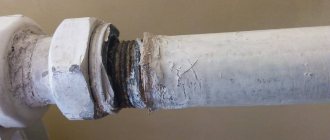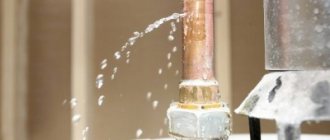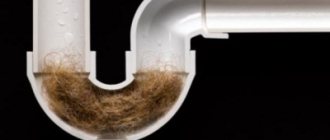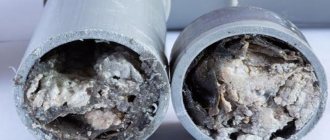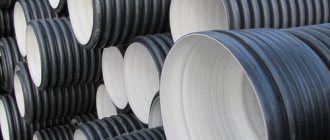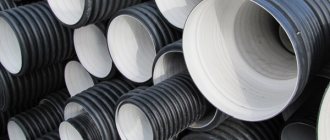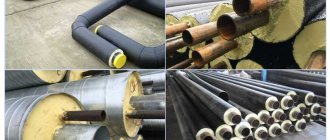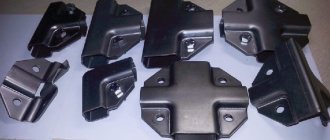When using pipelines to supply water or heating, depressurization often occurs - in this case, a repair bandage comes to the rescue. Pipe bandage is a special technical device for eliminating defects in pipelines that cause water leaks.
A distinctive feature of the bandage is its versatility; it can be effectively used to eliminate defects in metal, cast iron, polypropylene, polyethylene lines at pipe connections or in case of damage. In conditions where emergency repairs are required or bandage devices cannot be used, it is useful to know other ways to eliminate leaks in lines with your own hands, which are widely used in everyday life.
Fig.1 Pipe clamp and bandage - types
What is a bandage
A bandage or repair clamp is a device designed for repairing pipelines, has a rubber seal and is fixed to the surface using tightening screws. It consists of two connecting parts (strong, thick metal) or a solid metal plate (thin sheet steel) that is pushed onto the repaired area by expansion.
The products are produced in different diameters to fit standard pipe dimensions in inches; to join the parts, screws for a flat-head screwdriver, a Phillips screwdriver, or a hex wrench are used.
The main material for the manufacture of sliding devices is galvanized steel, grade 304 stainless steel; two-component types are made of duralumin, cast iron or similar alloys.
Depending on the design and purpose, bandages come in the following types:
- Double sided. They consist of parts connected with bolts and are available in different diameters depending on the product being repaired. One of the varieties is a two-part design with a threaded outlet for a tee connection.
- U-shaped. They are a metal bracket with holes along the edges into which a tightening fixing bolt with a nut is inserted.
- Clamp. The device consists of a round steel plate with slots along its entire length and an adjusting screw. This design allows you to change the diameter of the clamp within a wide range.
- Mounting clamp. Has a welded screw, designed for mounting pipes on various surfaces.
Rice. 2 Bandage for pipelines
Manufacturers of this product line
The building materials market provides various products from domestic and foreign manufacturers. Professional craftsmen deservedly highlight the high level of quality of goods from Israeli and Swiss companies.
Watch the video
Repair clamp "Gebo"
According to experts, the products of Dutch and German companies differ in the same level of quality. A lower level is occupied by products manufactured in Poland and China. The next place is occupied by clamps from domestic manufacturers. And the list ends with products from Denmark.
Almost all products that can be found on sale are manufactured according to European standards. They have all the necessary certificates for use in our country.
The line of these repair products is offered for sale in a very wide range, which allows them to be used on any mains, with any pipe diameter. The list of such highways also includes systems for transporting drinking water.
Application of bandages
Repair clamps are used in the following conditions:
- The devices are used in the repair of copper, steel, cast iron, asbestos-cement, ceramic, and various types of plastic pipelines in heating, water supply and sewerage systems.
- Repair bandage devices are installed only on vertical and horizontal sections of pipelines.
- The outer diameter of the pipes on which the bandage is used must correspond to its internal dimensions and in no case be less than its internal diameter.
- A clamp whose width corresponds to the outer pipe diameter should be used for pipe sizes of approximately 350 mm. The length of the clamp is selected to be 150 mm longer than the defect, and for large pipeline sizes - by 200 mm. wider than the damaged area.
- If it is necessary to repair a broken water pipe or join two of its parts, the distance between the sections should not exceed 10 mm, and the deviation angle should not exceed 2 - 3 degrees.
- The use of a bandage is ineffective if the damage size is more than 60% of its working area.
- When repairing a water or sewer PVC pipe, the width of the working part of the work should be one and a half times the size of the defect.
If the damage in the pipeline is long (longitudinal crack), to eliminate it, cut out the damaged section, insert a new section of pipe into the opening and install bandages on both sides.
Rice. 3 Installation of repair clamps
Parameters of products in this category
All pipe repair clamps are used in practice taking into account the following parameters:
- The operating pressure in the system can fluctuate between 6-10 atmospheres.
- The maximum temperature allowed when using the clamp is 120 ℃.
- Operating temperature fluctuations can range from -20℃ to 60℃.
- Pipe sections that can be repaired using clamps are 15-1200 mm.
- Fastening elements are made only from galvanized or stainless steel.
- A seal made of cellular corrugated rubber is installed on the crimp clamps.
- If the design of the clamp is crimp, it is made of galvanized steel with a thickness of 1-2 mm, but composite products are made of high-carbon steel grade 20, or, sometimes, of cast iron.
Fixing leaks in pipelines with your own hands using a bandage
The bandage is a specially designed device for eliminating leaks, ensuring high tightness and reliability of connections of all types of pipelines; its installation (two-component model) is carried out according to the following scheme:
1. Disassemble the repair clamp, unscrewing the connecting bolts, protect the surface of the pipeline from rust, paint and other types of contaminants.
2. Install the rubber gasket in the center of the damage so that its edges overlap the hole by 30 mm. on both sides;
Rice. 4 Repairing the water supply using a bandage
3. Place two metal halves on the gasket and connect them with four bolts, gradually tightening the bandage on both sides. However, you should not overtighten the connection if plastic pipes are being repaired - this can lead to their longitudinal cracks. When screwing, it is better to leave a small leak and wait some time so that the plastic rubber ring better grips the pipe and seals the hole tightly.
4. A two-component repair bandage can serve for at least 5 years; if necessary, you can always replace the rubber seal in case of a leak and use the product for an unlimited period.
Methods and materials for repairing steel pipes in heating systems
In addition to repair clamps, there is a fairly wide variety of methods for repairing damaged metal pipes, including various methods of applying patches and mechanical fasteners, which can be used in curved areas that are unsuitable for the use of bandages.
Rice. 5 Method for eliminating leaks in the hose using a medical tourniquet
Metal threaded bolt or self-tapping screw
If the diameter of the fistula is small on curved sections of the main line or in heating radiators, threaded metal fasteners are used for repair, screwed forcefully into the hole. To obtain the most reliable connection, proceed as follows:
- A hole is drilled in the pipe for a thread slightly larger than the size of the fistula, usually it is 0.5 - 1 mm smaller. standard diameter (4, 5, 6 mm and so on).
- Use a tap to cut a threaded profile for a bolt of the selected size.
- The bolt is cut so that its head rests on the edge of the hole during installation, after which a rubber gasket is placed on it and screwed into the hole.
A significant disadvantage of this method is that the bolt significantly blocks the water supply channel in small-diameter mains; for horizontal sewer lines, the method is not very suitable - fibrous waste will be retained on the protruding surface of the bolt.
Cold welding
Cold welding is a popular component for plugging various types of holes; its composition, penetrating into the product, is used to seal water pipes made of different materials for supplying cold and hot water.
When using cold welding proceed as follows:
- Be sure to shut off the water - when wet, the material has low adhesion to the metal and will be pushed out of the hole under pressure.
- Stir a small amount of the substance in rubber gloves and apply it to the defective area from above.
- After at least 10 minutes, the welding is polymerized and the product is ready for use; the material can withstand pressure of about 20 atmospheres and temperatures up to 260 C.
Rice. 6 Sealing a fistula using cold welding
Rubber bandage
You can repair a damaged steel pipeline using a rubber bandage cut from a glove, a bicycle inner tube, or a ready-made pharmaceutical product.
When using it proceed as follows:
- Wraps the damaged area in a spiral with a margin from bottom to top and returns to the middle of the fistula.
- An elastic bandage cannot withstand high pressure, so the point where the hole is located is strengthened by winding metal wire or a clamp.
The main advantage of using an elastic bandage is the ability to repair leaks in threaded connections of metal pipes using couplings (squeezes); during installation, the rubber bandage is tightly wound onto an uneven surface and secured with a steel tie or wire.
Rice. 7 Defective section of pipeline, wrapped in insulating material
Epoxy resin
Two-component epoxy resin is a popular material in everyday life, suitable for repairing any type of water pipes; the procedure for its use is as follows:
- Shut off the water, protect the area being treated from rust and paint with sandpaper or sharp objects, and then degrease.
- Mix a small amount of resin in a ratio of 1 to 10 components and prepare a medical bandage.
- Epoxy resin is applied to the surface with a margin of length and a cloth bandage is wound in a spiral, after which the next layer is smeared, followed by wrapping with a bandage.
Repair of water supply and sewerage systems made of cast iron
In residential buildings, cast iron is widely used in risers; leaks often occur at the socket connections with plastic outlets. There is practically no pressure in the riser, so its repair consists of simply sealing the defective area.
The technologies used in sealing steel lines and some other methods are suitable for carrying out this work.
Cement piping
If you don’t have an elastic bandage at hand, you can use regular gauze in combination with cement mortar, performing the following operations:
- Mix cement with water until a creamy mass is obtained.
- Dip a medical bandage into the solution and soak it with a cement composition.
- Wrap the defective area several times in a spiral in 3-4 layers.
- The pipeline can be used after the composition has dried a day later.
Caulking
The technique is used to close cracks and fistulas in cast iron pipes and involves driving lead rivets into the slot cavities. As a soft substance, lead reliably covers and seals the defective area when the hollow compartment is filled.
Rice. 9 Method for sealing leaks in cast iron pipes
Padding
Leaks often occur in the socket joints of cast iron elements; to seal them, packing made of fibrous materials impregnated with bitumen is used, the work is carried out in the following order:
- Remove the old packing using sharp objects, freeing up space for laying repair components.
- A jute or hemp rope (rope) impregnated with bitumen is tightly pushed into the resulting gap along the entire perimeter, leaving a distance of about 10 mm at the top.
- Cover the packing with cement mortar, covering the free space with it.
Chopiki
Chopik refers to a method of repairing Soviet-era cast iron and steel pipes; wooden plugs made from hardwood are used to seal holes. The main advantage is the closure of the fistula, through which water enters under pressure and there are no standard factory devices at hand, within a few minutes.
When using it, a wooden peg is sharpened at any angle and lightly driven into the hole; after exposure to moisture, the wood expands and tightly closes the fistula. In steel lines of the Soviet era, chopiks stood for 5 years; when leaks appeared as a result of widening holes, they were simply driven deeper.
Rice. 10 Method of repair work using choppers
Repair methods for plastic pipelines
Various plastic pipes are repaired using clamps, applying patches, and sealing holes.
For common polypropylene pipelines, a special technology has been developed, the essence of which is to seal the fistula with a heated polypropylene rod. In this case, the hole is drilled to the required diameter, its ends are heated with an iron rod inserted into a soldering iron, then a molten polypropylene pin is placed inside the hole, the protruding end of which is then cut off.
The second repair method is to cut out the damaged area, after which the pipe ends are connected with an external coupling using a plumber's soldering iron.
If you don’t have a special tool, you can try to repair the polypropylene pipe yourself by doing the following:
- Drain the water from the system, drill a round hole in the pipe and cut out a slightly larger rod from polypropylene (polypropylene rods are available for sale on the construction market).
- Melt the pipe hole with an inserted heated metal pin, while simultaneously heating the polypropylene insert until softened with a construction or household hairdryer, the air temperature of which reaches 800 C. (melting point of polypropylene is 260 C.)
- Place the heated insert into the hole, and after cooling, its upper end is cut off.
Technique for repairing PVC sewer pipes
Sewer lines are under low pressure and are connected using a socket method, so the easiest way to repair a hole or crack is to replace the damaged segment. If this is not possible, metal clamps or strapping with sealing strips, tape, or insulating tapes are used. You can stick a patch made of dense material onto the damaged area using a special PVC glue, seal it with epoxy resin or cold welding.
Rice. 11 Method for repairing plastic pipes
The use of a bandage in cases of damage to pipelines is the most effective way to repair them at home on straight sections. If damage occurs in hard-to-reach or curved places on bends, options using adhesives, tapes, and inserts made of various materials are used.
Let's look at what types there are
Repair clamps for metal and other pipes, depending on the material of manufacture, are divided into:
- Steel. Made from material not coated with anti-corrosion protection.
- Steel. Made of stainless material.
- Steel. (Galvanized).
- Cast iron.
Depending on the type of fastener, coupling devices for metal and other highways are:
- One-sided.
- Double sided.
- Standard.
- Two-part.
- Three-part (for large-volume metal pipelines).
In addition to these models, manufacturers provide a set of composite parts for metal systems with large diameters. And the number of component parts for such repair devices depends on the volume dimensions.
Watch the video
Repair clamp IGE INOXGIS
Products for metal and other pipes differ in several features of working designs, which means that they are easy to select for any network.
